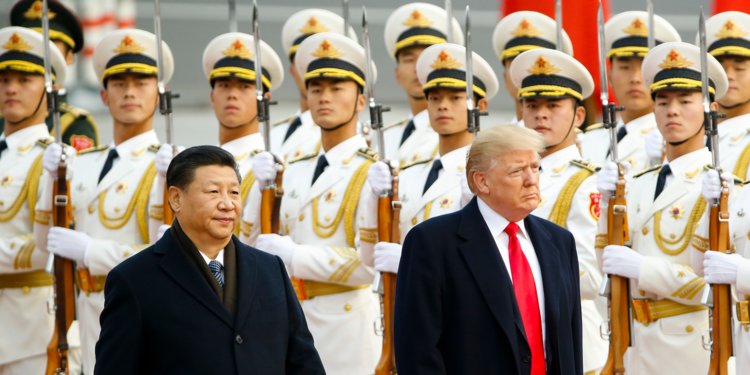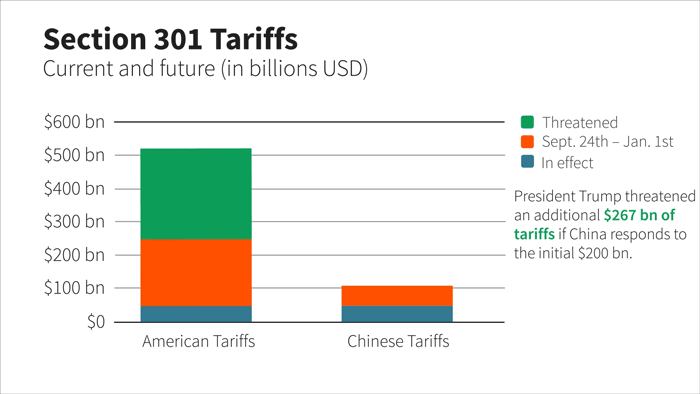- GOLD IRA
- Download Our 2024 Precious Metals IRA Investor’s Guide.
Click Here  Gold IRA
Gold IRA
 Investing
Investing
-
- CRYPTO IRA
- PRICES & STATS
- RETIREMENT PLANS
- BLOG
 Questions? Call (888) 820 1042
Questions? Call (888) 820 1042
Trade War Impacting Markets and Growth Forecasts for Both U.S. and China
Disclosure: Our content does not constitute financial advice. Speak to your financial advisor. We may earn money from companies reviewed. Learn more
Last Updated on: 30th November 2018, 05:33 pm

This past week saw world leaders preparing for the Buenos Aires G-20 summit as the trade war raged on between the United States and China. President Donald Trump had a meeting scheduled with the Chinese President Xi Jinping for the November 30th to December 1st meeting, but analysts are not expecting any significant breakthroughs. As the tensions in trade rage on, the knock on effects of the rapidly mounting tariffs and counter tariffs have started impacting growth forecasts for both countries.
Some economists and geopolitical observers have claimed that the trade conflict has led to a new Cold War with China. In the end, this clash of the two civilizations which represent the two largest economies in the world could be what brings down the decade-long bull market recovery from the Global Financial Crisis and Great Recession of 2007-2009. Gold makes sense in an IRA as the geopolitical mess in the world spirals further out of control. Now is the time to consider your IRA-approved precious metals and the Gold IRA rules and regulations.
Low Expectations to End the Trade War Any Time Soon
Global Chief Economist Marie Owens Thomsen of Indosuez Wealth Management has warned that the ongoing trade war with China is far from winding down, despite the sit-down meeting coming between Trump and Xi.
“The congress has given executive authority to the president to negotiate without necessarily asking the Congress each and every time, and as long as that sort of delegated power sits with the president, I feel [trade] will continue to be a theme as we go forward. Unfortunately, I think that in all probability, trade will continue to be one of the favorite battle horses of this administration.”
Thomsen is not alone in these assessments. Other economists have an even grimmer view. Yale University Economist Stephen Roach echoed such sentiments to CNBC on Friday with his dire comments:
“I think the end game is that this is a clash between two systems. And the U.S. is objecting to a state-sponsored ‘market-based socialist system' that uses the largess of the state to subsidize industrial policy.” This global trade conflict will likely go on for a “long, long time.”
These various assessments were delivered just ahead of the critical meeting between the American and Chinese presidents this weekend with the top 19 trading economies plus the European Union converging on Argentina's capital. Thomsen considers this bilateral meeting to be of paramount importance as in his view it is necessary for global stock markets and the international economy to have a trade arrangement and agreement with the United States and China hammered out.
Yet neither Thomsen nor Roach is optimistic over the short term outcome. Both believe the situation will continue to deteriorate following the G-20 gathering. Consider yourself fairly warned.
G-20 Prepares to Meet With Tariff War Between U.S. and China Raging On
The G-20 meeting has many thorny issues swirling around it for this weekend, including Brexit and the future of the world's fifth largest economy and largest trading/economic block the EU, Saudi Arabia and Russia's conspiring together on world oil supplies and prices, Turkey's ongoing economic problems and the increasing authoritarianism of President Erdogan, and Italy's budget defiance of the European Union. Yet overshadowing all topics of concern is the trade and tariff dispute between China and America.
No one is holding his breath on a breakthrough though. U.S. tariffs on China will rise to 25 percent at the beginning of 2019. This is not the end of it. President Trump has a threat on the table to erect tariffs on goods totaling another $267 billion should Beijing not give in to U.S. (and other Western nations'silent) demands. The chart below shows how serious this is:

At that point, the U.S. will have duties on nearly all Chinese exports to America. The United States is demanding that China stop subsidizing its businesses and provide fair market access to American companies to aid in reducing the $375 billion gap in bilateral trade balance. Investors now anticipate that there will be an economic activity and corporate earnings slowdown this coming year, according to Reuters.
This has all been supportive of gold prospects. Goldman Sachs released a report on Monday extolling the long entry point for gold and several other commodities, with:
“Given the size of dislocations in commodity pricing relative to fundamentals with oil now having joined metals in pricing below cost support, we believe commodities offer an extremely attractive entry point for longs in oil, gold, and base [metals].”
Oil could also prove volatile depending on the outcome of Russian President Vladimir Putin's sideline meeting with Saudi Arabian Crown Prince Mohammed bin Salman.
U.S. and China Have Entered A New Cold War?
The most concerning part of the latest trade war tensions between Washington and Beijing surrounds analyst assessments that the two economic global superpowers have already undertaken a new “Cold War.” Economist Stephen Roach made this case on the last day of November as did Britain's Morningstar UK.
Morningstar U.K. argues that the U.S. Vice President Mike Pence has been out on a tireless crusade of speeches using undisguised language on the issues of Chinese malfeasance in areas including cyber attacks, interference with U.S. elections, stealing of U.S. corporate technology, and unfair government sponsored subsidies. Trade is only the tip of the proverbial iceberg.
The centerpiece of China's ambitious advance into U.S.-dominated high technology industries is called “Made in China 2025.” The U.S. administration has taken this new intense focus on artificial intelligence and robotics personally. It has moved the battle front on from trade to encompass technology and investment as well. The U.S. is standing up to the illegal methods of pursuing government-mandated industrial policy that includes both stealing and strong arming technology and intellectual property from American enterprises.
The Chinese now see these goals of the U.S. as an American obsession with stopping the Chinese advance towards geopolitical, economic, and military equality with the United States. Beijing has become increasingly convinced that Washington has decided to stop their inexorable rise by all possible means. Vice President Pence landed an especially embarrassing blow against Beijing by heralding rival Chinese state Taiwan as a global example of politics and democracy, all the while criticizing the authoritarian mainland Chinese of practicing only “lip service to reform and opening.”
Tariffs Are Causing Real Economic Impacts That Could Soon Worsen
If this is indeed a clash of civilizations and values as well as an economic contest for domination of the world's future, then the economic consequences to the rest of the world and both countries' economies may be a casualty both are prepared to bear. The IMF recently warned about slowing global growth, reducing its projections for both the United States and China by .2 percent for 2019 in its most recent World Economic Outlook. This does not yet take into consideration the more punishing tariffs and counter-tariffs which will aggressively ramp up over the coming few months.
Come January 1st, the next tariff wave will kick in, raising import penalties from the current 10 percent to a more punishing 25 percent. With the final wave of U.S. tariffs on Beijing set to take effect some time first quarter 2019, the incremental U.S. tariffs on China average could rise to a sobering 17 percent by 2019 second quarter. Businesses and workers in impacted other industries will likely be affected going forward, vastly increasing the amount of economic damage to China and eventually the U.S. as well.
The really big concern is that pushing China into a corner will do more than simply cause Beijing to dig in defensively for the long haul by taking on greater debt to soften the near-term economic effects from the tariffs. Remember that Beijing holds around a trillion dollars of U.S. government debt in the form of Treasuries. It can crush the U.S. Treasury market at any time by pushing a few sell buttons. The ramifications of this move would include skyrocketing interest rates across all industries and forms of credit and borrowing in the U.S.
You do not need to live in fear of what all of this means for your investment and retirement portfolios. Look into the top five gold coins for investors now while you still can. You should consider what is involved with the choice of a Gold IRA rollover versus transfer before the situation deteriorates any more.



 Silver
Silver Gold
Gold Platinum
Platinum Palladium
Palladium Bitcoin
Bitcoin Ethereum
Ethereum

 Gold: $2,387.15
Gold: $2,387.15
 Silver: $27.92
Silver: $27.92
 Platinum: $931.67
Platinum: $931.67
 Palladium: $903.43
Palladium: $903.43
 Bitcoin: $67,909.13
Bitcoin: $67,909.13
 Ethereum: $3,254.68
Ethereum: $3,254.68